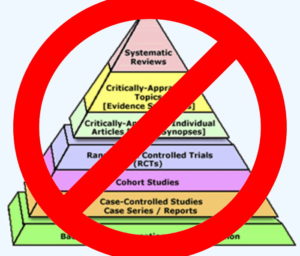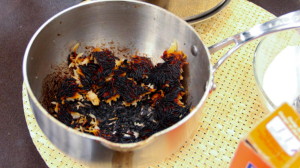The most important thing
I get asked a lot about critical appraisal (i.e. how to read a research paper). I have never had a good answer because it’s not a single skill, but the convergence of many skills coming together to help you understand what someone else has done in their experiment and how that applies to both the actual question they answered and the context in which that answer fits in the larger context of the field in which they are doing the work. Read More...
Ping-ponging with IFAST on mentorship (Part 1)
I was going to write a post about belief and mentoring, but the post took on a life of its own and this tangent became so important that I thought breaking the idea up into two parts would be better. Read More...
“Why is a plastic surgeon concerned about respiration?”
This was the most frequently asked question of this weekend at the Myokinematics course hosted by my friend Bill Hartman at IFAST. I am not going to reveal the second and third most frequently asked questions because some things that are asked at Myokin stay at Myokin. Read More...
The long-anticipated fall of the systematic review
 You may have noticed that for a blog that is called “Evidence-Based Fitness”, that there is not one single mention or reference to the “Hierarchy of Evidence” pyramid. This is entirely intentional. I can’t count the number of blog drafts that I’ve tried to write and then scrapped on how much I hated the old “hierarchy of evidence”. But this week, the Evidence-Based Medicine “pyramid” has finally been reworked. It’s not as graphically pretty. It does, however, better reflect the reality of the “this is not actually how it works” pyramid of old. The new infographic was revealed and can be found here (it’s even open access!) So what does this new infographic mean?
You may have noticed that for a blog that is called “Evidence-Based Fitness”, that there is not one single mention or reference to the “Hierarchy of Evidence” pyramid. This is entirely intentional. I can’t count the number of blog drafts that I’ve tried to write and then scrapped on how much I hated the old “hierarchy of evidence”. But this week, the Evidence-Based Medicine “pyramid” has finally been reworked. It’s not as graphically pretty. It does, however, better reflect the reality of the “this is not actually how it works” pyramid of old. The new infographic was revealed and can be found here (it’s even open access!) So what does this new infographic mean?
In a nutshell, it means there are no more simple answers and no more simple classifications. It means you can’t skip steps. It hopefully means an end to the blind application of a clearly dysfunctional classification system to interpret and compare studies to one another. Read More...
Blindness to costs
Evidence helps me make decisions when the cost of intervention is high and immediate. Once I make the cut, I can never take it back. There are no do-overs and the damage I personally inflict on a patient is instant. Surgery is a calculated intentional harm for the chance at a net gain. This is in contrast to exercise and nutrition where change is more gradual and where the cost of intervention is perceived (rightly or wrongly) as mostly time and this vague thing we call effort. But the immediacy of time should not be overlooked as a high cost. Perhaps therein lies the rub: fitness “professionals” fail to see the costs of their own interventions; because if you could see that high cost, you would use EVERY resource available to you to make the right decision. Read More...
STAHP! Please, just STAHP.
 There’s a dark humour quote in surgery, “There is no surgery so simple that a resident can’t screw it up.” I’ve decided to make up an adage, “There is no concept or idea that the fitness/nutrition industry can’t corrupt,” because I never thought I would have to ever, ever, write a post like this.
There’s a dark humour quote in surgery, “There is no surgery so simple that a resident can’t screw it up.” I’ve decided to make up an adage, “There is no concept or idea that the fitness/nutrition industry can’t corrupt,” because I never thought I would have to ever, ever, write a post like this.
It astonishes me that there is now a clear line in the sand between “evidence-based” trainers and non-“evidence-based” trainers. There’s even a third camp, which I’ll nick-name the “anti-evidence-based” trainers, where it’s not just a passive, I-don’t-really-read-much-research, but an active, I-explicitly-ignore-and-deride-research. Read More...
Why Asians are thinner: On Cultural Reduction and Health (Contains offensive language)
 Recently, a very prominent website published an article on why Asians tend to be thinner than what I can only presume to be Caucasians (as the writer is Caucasian). It’s not the first article on this topic and it won’t be the last (there is, after all, an entire field of study on comparing cultural behaviours and “health”. Whether this is a worthwhile field or not, I have yet to decide), but the treatment of the material was so completely out-to-lunch racist, that I could not fight posting about it.
Recently, a very prominent website published an article on why Asians tend to be thinner than what I can only presume to be Caucasians (as the writer is Caucasian). It’s not the first article on this topic and it won’t be the last (there is, after all, an entire field of study on comparing cultural behaviours and “health”. Whether this is a worthwhile field or not, I have yet to decide), but the treatment of the material was so completely out-to-lunch racist, that I could not fight posting about it.
The colonial narrative is healthy and strong, even in the fitness world. Other cultures become exoticized and romanticized as though they are not really part of the world of the writer. It’s both disappointing and amusing to read until you realize that the entire premise of such stories is to separate, perpetuating a ‘them vs us’ mentality, particularly when based on a thoroughly inadequate experience of what it means to be of another culture (This petition was created in response to a newspaper article on Filipino cuisine as experienced by a naive Caucasian traveller). It results in the inappropriate homogenization of many cultures under a single, reduced label. This essentially invalidates the richness of what it means to experience any one of those cultures expressed in a myriad of combinations. Read More...
All studies are wrong, unless they’re not
 You know me. I’m always late to the internet parties.
You know me. I’m always late to the internet parties.
Recently, a few more click-bait sites have gone on to talk about how most research findings are false. A few months ago, the article, “Why you shouldn’t believe that exciting new medical study.” was making the rounds or, as the young folks say, “trending”. Yes, it has taken me that long to get my thoughts together on it. Read More...
Systematic Reviews: All that glitters is not gold.
This is a short article I submitted to Science-Based Medicine a couple of years ago, which never made it to their blog and then I forgot about it. But then I came across it and figured I should use it since I already did the work; and lately there seem to be a lot of systematic reviews being published. Read More...
50 ways to take a better poop

An actual ad that I passed by whilst on the escalator on the Hong Kong subway for a ‘digestive aid’ targeted at women
Everybody poops. You don’t even have to learn how, unless it’s important to go in the potty (and it is.) So really, this is going to be a single item list: Read More...

